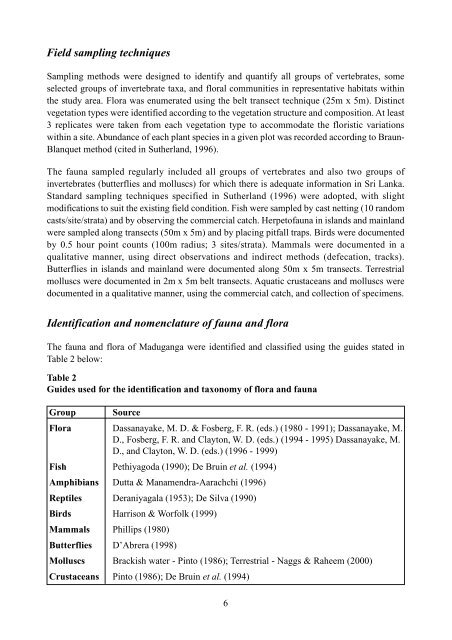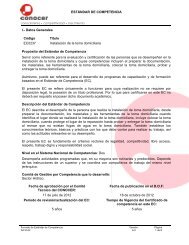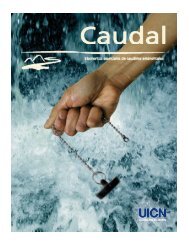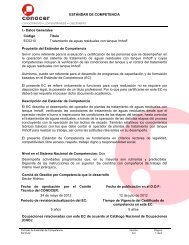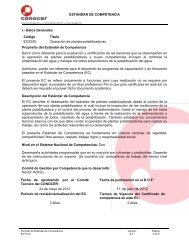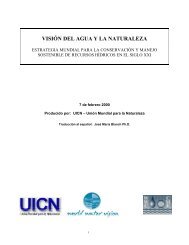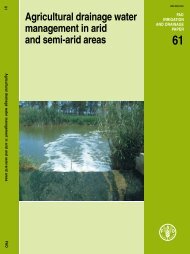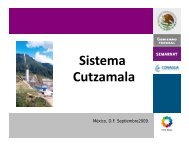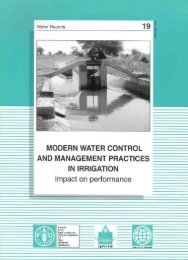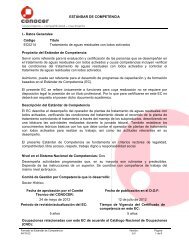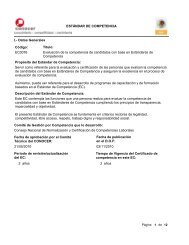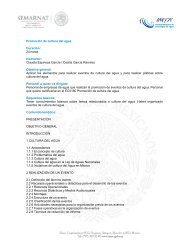An Assessment of the Status of Biodiversity in the ... - IUCN
An Assessment of the Status of Biodiversity in the ... - IUCN
An Assessment of the Status of Biodiversity in the ... - IUCN
Create successful ePaper yourself
Turn your PDF publications into a flip-book with our unique Google optimized e-Paper software.
Field sampl<strong>in</strong>g techniquesSampl<strong>in</strong>g methods were designed to identify and quantify all groups <strong>of</strong> vertebrates, someselected groups <strong>of</strong> <strong>in</strong>vertebrate taxa, and floral communities <strong>in</strong> representative habitats with<strong>in</strong><strong>the</strong> study area. Flora was enumerated us<strong>in</strong>g <strong>the</strong> belt transect technique (25m x 5m). Dist<strong>in</strong>ctvegetation types were identified accord<strong>in</strong>g to <strong>the</strong> vegetation structure and composition. At least3 replicates were taken from each vegetation type to accommodate <strong>the</strong> floristic variationswith<strong>in</strong> a site. Abundance <strong>of</strong> each plant species <strong>in</strong> a given plot was recorded accord<strong>in</strong>g to Braun-Blanquet method (cited <strong>in</strong> Su<strong>the</strong>rland, 1996).The fauna sampled regularly <strong>in</strong>cluded all groups <strong>of</strong> vertebrates and also two groups <strong>of</strong><strong>in</strong>vertebrates (butterflies and molluscs) for which <strong>the</strong>re is adequate <strong>in</strong>formation <strong>in</strong> Sri Lanka.Standard sampl<strong>in</strong>g techniques specified <strong>in</strong> Su<strong>the</strong>rland (1996) were adopted, with slightmodifications to suit <strong>the</strong> exist<strong>in</strong>g field condition. Fish were sampled by cast nett<strong>in</strong>g (10 randomcasts/site/strata) and by observ<strong>in</strong>g <strong>the</strong> commercial catch. Herpet<strong>of</strong>auna <strong>in</strong> islands and ma<strong>in</strong>landwere sampled along transects (50m x 5m) and by plac<strong>in</strong>g pitfall traps. Birds were documentedby 0.5 hour po<strong>in</strong>t counts (100m radius; 3 sites/strata). Mammals were documented <strong>in</strong> aqualitative manner, us<strong>in</strong>g direct observations and <strong>in</strong>direct methods (defecation, tracks).Butterflies <strong>in</strong> islands and ma<strong>in</strong>land were documented along 50m x 5m transects. Terrestrialmolluscs were documented <strong>in</strong> 2m x 5m belt transects. Aquatic crustaceans and molluscs weredocumented <strong>in</strong> a qualitative manner, us<strong>in</strong>g <strong>the</strong> commercial catch, and collection <strong>of</strong> specimens.Identification and nomenclature <strong>of</strong> fauna and floraThe fauna and flora <strong>of</strong> Maduganga were identified and classified us<strong>in</strong>g <strong>the</strong> guides stated <strong>in</strong>Table 2 below:Table 2Guides used for <strong>the</strong> identification and taxonomy <strong>of</strong> flora and faunaGroupSourceFlora Dassanayake, M. D. & Fosberg, F. R. (eds.) (1980 - 1991); Dassanayake, M.D., Fosberg, F. R. and Clayton, W. D. (eds.) (1994 - 1995) Dassanayake, M.D., and Clayton, W. D. (eds.) (1996 - 1999)Fish Pethiyagoda (1990); De Bru<strong>in</strong> et al. (1994)Amphibians Dutta & Manamendra-Aarachchi (1996)Reptiles Deraniyagala (1953); De Silva (1990)Birds Harrison & Worfolk (1999)Mammals Phillips (1980)Butterflies D’Abrera (1998)Molluscs Brackish water - P<strong>in</strong>to (1986); Terrestrial - Naggs & Raheem (2000)Crustaceans P<strong>in</strong>to (1986); De Bru<strong>in</strong> et al. (1994)6


